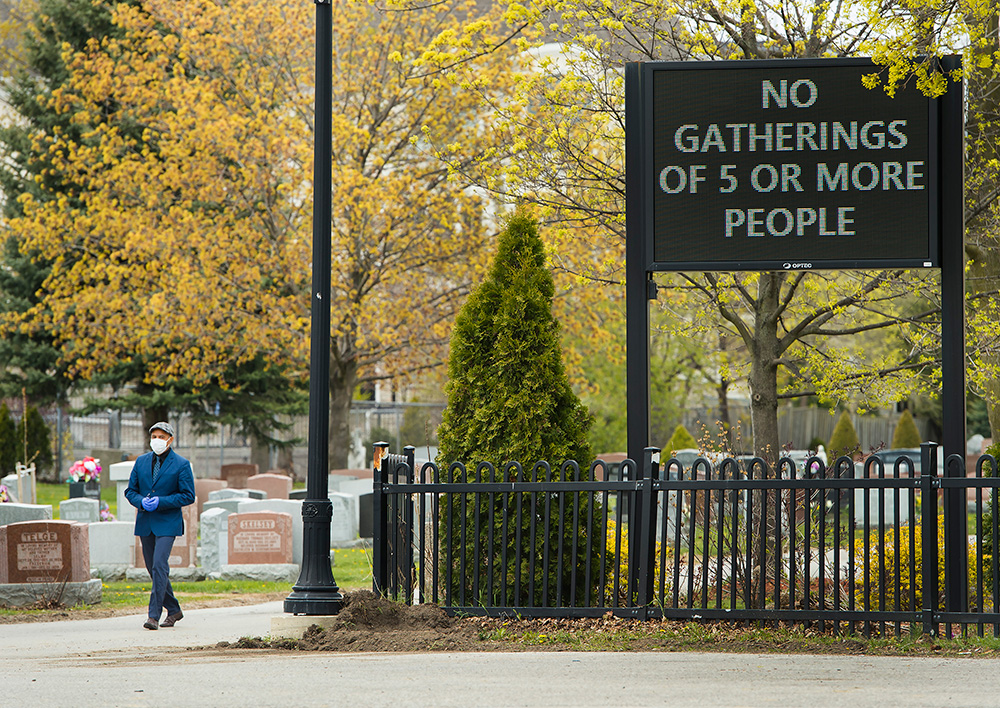The number of Canadians who died of COVID-19 could be twice as high as reported, according to a new preliminary report.
At least 6,000 COVID deaths in the community before last November likely weren’t attributed to the virus, meaning about two-thirds of deaths outside long-term care and hospital settings were missed, the peer-reviewed report estimates.
And if unattributed COVID-19 deaths continued at the same pace since November, Canada’s pandemic death toll could be closer to 52,000 people, double the 26,000 plus deaths recorded so far.
The peer-reviewed report from the Royal Society of Canada indicates that Canada fared much worse in the pandemic than previously thought, even before the disastrous second and third waves set in.
Poor cause-of-death data and limited access to testing for isolated seniors and their caregivers and low-income and racialized communities likely meant many deaths were not recognized or recorded as COVID-19, particularly in the early days of the pandemic, the report said.
And while British Columbia touted its successful handling of the pandemic, with a per-capita death rate that was 15 per cent lower than the national average during the first wave, the new report estimates that nearly four times as many people over 45 died of COVID-19 before December than previously reported.
That means that while B.C. had reported 435 deaths before November, the death toll could have been over 1,700.
B.C. has officially recorded 1,749 deaths due to COVID-19, an outcome Premier John Horgan called “extraordinary” on Tuesday in light of higher mortality rates in other Canadian jurisdictions.
But infectious diseases expert and report co-author Dr. Tara Moriarty told The Tyee the province’s actual per capita mortality rate is likely closer to the Canadian average.
“B.C. definitely did quite a bit worse than the perception,” said Moriarty.
When asked about the report, which also found that data reporting issues in B.C. are “particularly acute,” provincial health officer Dr. Bonnie Henry said it should be taken “with a grain of salt.”
“I don’t agree with what that report has come out with. I think there are variations, that they have made assumptions between what happened in Ontario, for example, and what happened here,” Henry said Tuesday. “Undoubtedly, there are some deaths that we missed early on. It’s just a function of the testing capacity.”
In response to Henry’s comments, Moriarty said data and trends from Ontario weren't used to make assumptions about what happened in B.C., and that limited up-to-date cause of death data in the province makes it difficult to assess how many COVID-19 deaths may have been misattributed to other causes.
What the report surveyed
The report surveyed excess death reports from across Canada, trends in reported pandemic deaths, cremation data to track increasing at-home death numbers and antibody surveillance testing to estimate missed infections and deaths in the community.
It aimed to pinpoint the number of direct COVID-19 deaths. It excluded deaths related to the surge in toxic drugs and those caused by pandemic prevention measures that closed services by using age-adjusted mortality data from the last several years.
The report’s estimate of thousands more community deaths would mean that deaths in long-term care likely accounted for 45 per cent of deaths, not 80 per cent as previously thought, bringing Canada closer in line with other OECD countries.
Deaths in long-term care are likely still underreported, but not nearly as much as deaths in the community, where events and symptoms leading to death are not as closely monitored, particularly for isolated seniors, said co-author and geriatrician Dr. Janet McElhaney.
Many of the uncounted deaths were likely adults over 45 living in dense, low-income and racialized neighbourhoods, the report found, and they were likely obscured and missed by poor death reporting practices, difficult access to testing and atypical or hard to recognize COVID-19 symptoms.
Limiting tests to health-care workers or close contacts of known cases, as B.C. did in its early days, meant that many deaths went uncounted in the pandemic’s toll, the report found. Many people may have feared the exposure risk of going to get tested or not recognized their symptoms as COVID-19 and died before being diagnosed with the disease.
Canada’s per capita testing rate for COVID-19 is about 75 per cent less than other comparable countries.
Older people are also more likely to present atypical or asymptomatic COVID-19. For example, a community-based senior in their 80s may have had nausea and fatigue, not recognized it as COVID-19, and not been tested before their death, which makes it more likely to be classified as a natural death.
“B.C. death reporting really lags behind the pandemic, in terms of recognizing and reporting that these deaths were happening,” said McElhaney, noting all-cause death data in B.C. is up to date only until February 2020.
The province has worked with the BC Coroners Service to ensure all sudden and unexpected deaths in the community are tested for COVID-19, Henry said, and has reported on mortality data during the pandemic as well.
“The vast majority of deaths that we saw were related to COVID in older age groups and related to the overdose crisis in younger age groups,” she added.
There is also evidence that some sudden deaths in the community were due to people not seeking care for acute and chronic health conditions due to fear of the virus, Henry noted. “This is absolutely something that we are continuing to monitor and change and to try and understand.”
Quebec tested all deaths for COVID-19 infection.
‘Systemic ignorance’
The report suggests that approximately 80 per cent of estimated excess deaths occurred either weeks before or between major spikes in reported cases, particularly during summer 2020.
This information, just like missing disaggregated race-based data, would have been crucial to understanding where and how the virus was spreading, and how to protect communities early on in the pandemic’s course.
“We missed, actually, the fact that this pandemic was on us, the second wave was here earlier, and the chance to start developing measures where we can see what the impact is of the pandemic before we started to see more deaths in long-term care,” said McElhaney.
Similar to poor death reporting, a lack of disaggregated race-based data for COVID-19 cases and deaths means B.C. and many other Canadian jurisdictions didn’t have a handle on the pandemic’s trajectory after decades of ignoring and underfunding racialized communities.
“It speaks to our systemic ignorance,” said study co-author Eemaan Kaur Thind. “We’re likely missing so many deaths, especially in minoritized communities.”
The effects of systematic racism mean that a disproportionate number of racialized people are low-income, work in frontline, minimum wage jobs,and often face language and financial barriers to health care that leave them with chronic health issues, said Thind.
This means racialized people are both more likely to contract the virus at work or in their communities and are also at higher risk of serious illness and death.
Deaths due to COVID-19 were on average twice as high per capita in neighbourhoods where there is a large proportion of visible minorities, according to a previous study. In B.C., that rate was more than 11 times as high.
“It’s not that having higher melanin in your skin means you’re more likely to get sick or die from COVID-19,” said Thind. “It’s basically systemic racism and other social determinants of health at play.”
Listening to communities to understand what they need is essential, Thind said, but the public health system should not need the people bearing the brunt of the pandemic to advocate in order to protect them.
But the fact the Canadian health system runs on advocacy is nothing new, Moriarty said, and needs to be reformed to prevent a future pandemic wreaking the same devastation again.
“It’s almost coming to light too late,” said Moriarty. “We need every province reporting those deaths in a timely manner, we need to know if deaths are abnormally high, and if so, why?”
There are likely many more people, particularly seniors in the community, whose function and qualities of life have declined.
“All these people died, but there are a whole bunch of people who we missed who are that much closer to not being able to be independent in the community,” said McElhaney.
The report recommends overhauling Canada’s death-reporting system to report preliminary death rates weekly and monthly, adopting the United States’ Centers for Disease Control’s methods for estimating excess mortality in Canada, mandating a national task force on COVID-19 mortality and testing everyone who dies whether in hospital or in the community for COVID-19.
But the report also raises disturbing questions, with implications not just for future pandemics but how a siloed system fails and marginalizes racialized, elderly and disabled people.
“We also need to grapple with, morally and ethically, how we missed so many deaths,” said Moriaty. “Why didn’t we see them?”
“I’m afraid they were people others didn’t notice, and their deaths weren’t really remarked upon.” ![]()
Read more: Rights + Justice, Coronavirus
















Tyee Commenting Guidelines
Comments that violate guidelines risk being deleted, and violations may result in a temporary or permanent user ban. Maintain the spirit of good conversation to stay in the discussion.
*Please note The Tyee is not a forum for spreading misinformation about COVID-19, denying its existence or minimizing its risk to public health.
Do:
Do not: